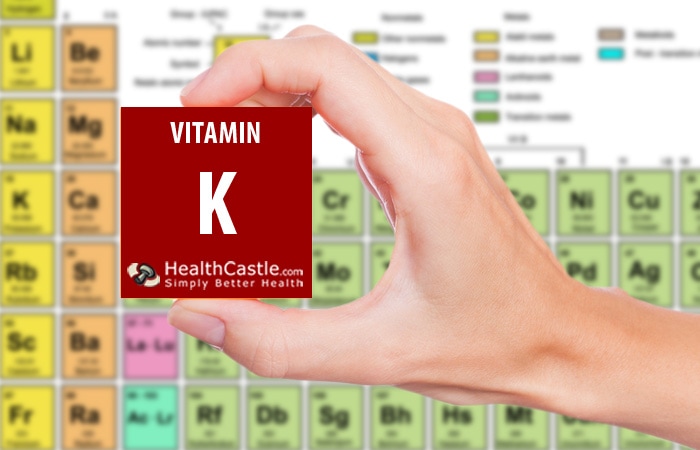
Written By: Carolyn Berry, RD
Title: Registered Dietitian
Alumni: University of British Columbia
Last Updated on:


Vitamin K is a fat-soluble vitamin, meaning that your body stores it in fat tissue and the liver. It is best known for its role in helping blood clot, or coagulate, properly. In fact, the letter “K” in the name of this vitamin originally came from the German word koagulation.
Table of Contents
The Dietary Reference Intakes (DRI) for Vitamin K are shown below:
| Age Group | Recommended Dietary Allowance (RDA) per Day | Tolerable Upper Intake Level (UL) per Day |
| Adults | ||
| 19 years and up | 120 mcg men
90 mcg women |
*No upper limit is established for this nutrient |
| Kids and Youth | ||
| 1 to 3 years | 30 mcg | |
| 4 to 8 years | 55 mcg | |
| 9 to 13 years | 60 mcg | |
| 14 to 18 years | 75 mcg | |
| Special Considerations | ||
| Pregnant women 14 to 18 years | 75 mcg | |
| Pregnant women 19 years and up | 90 mcg | |
| Lactating women 14 to 18 years | 75 mcg | |
| Lactating women 19 years and up | 90 mcg |
Vitamin K is best known for its role in healthy blood clotting. It acts as a coenzyme that assists in the synthesis of a number of proteins involved in the coagulation of blood. It helps keep our blood clotting ability at exactly the right level so that our blood is not too thick or too thin. Without adequate Vitamin K, blood does not clot properly. This can include delayed clotting time or for clotting not to occur at all. The latter can lead to increased bleeding from even minor wounds as well as internal hemorrhaging.
Warfarin (also known as Coumadin) is a widely used anticoagulant drug that interrupts the clotting process. For individuals with an excessive tendency to form blood clots, anticoagulant drugs like Warfarin can be life saving.
Vitamin K is a critical nutrient in bone health because it protects bones from weakening or fracture. It does this through two mechanisms. First, it blocks the formation of too many osteoclasts, which are the bone cells in charge of bone demineralization. Though the activity of these cells is very important for proper health, having too many osteoclasts leads to bone demineralization. The second mechanism is Vitamin K’s involvement in a process called carboxylation. For our bones to be optimally healthy, one of the proteins found in bone, called osteocalcin, needs to be chemically altered through the process of carboxylation. When too few of the osteocalcin proteins in bone are carboxylated, the bones have increased risk for fracture.
Vitamin K helps to prevent calcification of blood vessels or heart valves. Calcification is build-up of calcium inside a tissue that is normally soft, which causes the tissue to harden and stop functioning properly. This is a common problem in many forms of heart disease and is typically referred to as hardening of the arteries. Vitamin K helps to prevent this calcification process from happening. Researchers have determined that individuals with Vitamin K deficiency are at greater risk for hardening of the arteries than individuals with healthy Vitamin K intake.
Dark green leafy vegetables are the best sources of Vitamin K. Plant oils like canola and soybean oil are also good sources of Vitamin K. Our bodies are able to make a small amount of Vitamin K.
| Food | Vitamin K per serving |
| Parsley, raw, 1/2 cup | 492 mcg |
| Kale, raw, 1 cup | 472.2 mcg |
| Swiss chard, raw, 1 cup | 298.8 mcg |
| Collard greens, raw, 1 cup | 157.4 mcg |
| Spinach, raw, 1 cup | 144.9 mcg |
| Turnip greens, raw, 1 cup | 138.0 mcg |
| Broccoli, cooked, 1/2 cup | 110.1 mcg |
| Brussels sprouts, cooked, 1/2 cup | 109.4 mcg |
| Scallions, raw, 1/2 cup | 103.5 mcg |
| Romaine lettuce, raw, 1 cup | 48.2 mcg |
| Soybean oil, 1 tbsp | 25 mcg |
| Canola oil, 1 tbsp | 10 mcg |
In the United States: The daily value (DV) for Vitamin K is 80 mg, which is lower than the DRI for adults. The number you see on the Nutrition Facts label is a percentage calculated by dividing the amount of Vitamin K in one serving of the food by the DV. Using an example from the above chart, 1/2 cup of cooked broccoli, which contains 110.1 mcg of Vitamin K, would have 138% of the DV for Vitamin K. The FDA does not require food labels to list the DV or amount for Vitamin K.
In Canada: The daily value for Vitamin K in Canada is also 80 mg. The CFIA does not require food labels to list the DV or amount of Vitamin K on the Nutrition Facts label.
Vitamin E: Very high doses of Vitamin E can make Vitamin K less effective for clotting blood. In people who are taking Warfarin, or in people who have low Vitamin K intakes, high doses of Vitamin E can increase the risk of bleeding.
Alumni: University of British Columbia – Carolyn Berry is a Vancouver-based Registered Dietitian, self-proclaimed foodie, marathon runner, and owner of Berry Nourished. Carolyn works in a variety of areas including clinical nutrition, outpatient counselling at Medisys Preventive Health Clinic, as a nutrition tour leader with Save-On-Foods, and in the media, including segments on CBC Television, CKNW and Spice Radio. Through informative and practical nutrition advice and her food-first approach to health, Carolyn fulfills her passion to empower others with knowledge about nutrition so that they can make the best decisions to improve their health. She strongly believes that food should be both healthful and delicious.
blood clotting, micronutrient - vitamins, vitamin k, vitamins, vitamins - minerals